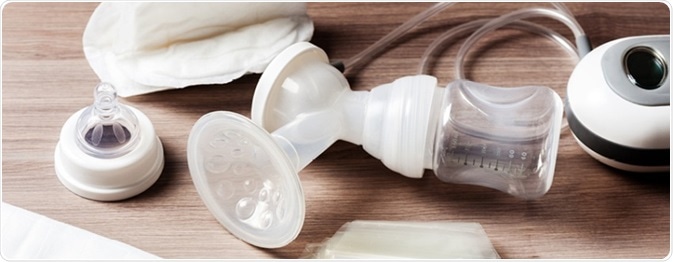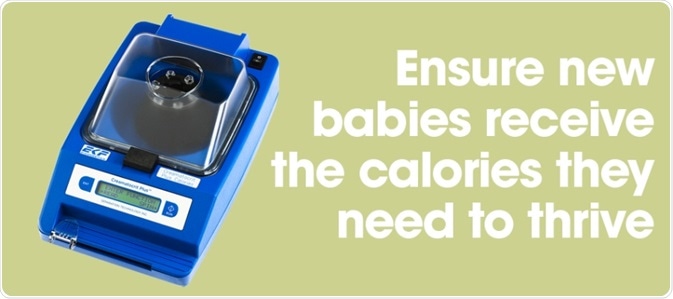
Image Credit: EKF Diagnostics
The lipid content in a mother’s milk can be measured quickly and accurately using the creamatocrit. Since 1978 it has been used extensively in lactation research . It requires a few drops of milk placed in a capillary tube to be centrifuged so that the lipid – or “cream” – separates from the aqueous part of the milk. This allows for calculation of the percent of cream to total milk volume, which is then converted in order to estimate the lipid and caloric content.
A cumbersome laboratory centrifuge and calipers, was used to perform the creamatocrit test previously, which limited its clinical use.
Why is It Useful to Measure the Lipid and Calories in Breast Milk?
Being able to see their own breast milk’s nutritional value can be beneficial for mothers, particularly of premature babies. Mothers can go back to the NICU and speak to the doctor with confidence regarding the caloric supplementation of their breast milk, they will often receive approval for vitamin and mineral supplementation but not supplementation for calories.
How is Creamatocrit Used?
- To support and motivate women in breastfeeding
- To inform mothers and doctors when a baby is not gaining the desired weight

Image Credit: EKF Diagnostics
How to Increase Fat in Breast Milk?
Throughout a pumping session and at different times of the day, milk production and it’s amount of fat content can vary greatly. A baby may have trouble gaining weight if they don’t get enough fat. An increase in fat in mothers’ milk will help babies grow.
Foremilk and Hindmilk
The “foremilk” is the initial milk that is released from the breast during a pumping or feeding session. The “foremilk” contains protein and other nutrients, but it is mostly water and, as such, is low in calories and fat.
The level of fat in the milk (and therefore calories) increases as the breast empties. The “hindmilk” is the milk right at the end of a pumping or breastfeeding session.
If a mother produced more than 900 ml of milk per day or if she expresses more than 200 ml in one feeding or pumping session, then the milk may be watery. If this is the case then the milk can be separated to isolate the milk that is higher in fat and calories.
It often helps to understand just how much milk is expressed from each breast during a pumping session. The mother may be advised to collect the first one-third of expressed milk in a separate container, then only feeding the baby with the remaining two thirds of expressed milk.
Testing the Fat
The amount of fat and calories in the breast milk can be measured with a creamatocrit analyzer. This provides the baby’s care team with information on the exact number of calories the baby receives. Human milk usually contains about 20 calories per ounce. However, the fat content can vary hugely throughout the day and during a single pumping session. It is possible for mothers to save milk that has been pumped at different times of the day, so it can be tested to provide a better understanding of the amount of fat and calories in the breast milk.
Fractionation of Human Milk
A creamatocrit centrifuge is used to evaluate the fat and calorie content of the milk, as this can vary hugely from mother to mother and even during a single pumping session with one mother. Support can be provided to mothers to separate their milk in order to provide the best nutrition to their infant.
Directions for Separating Milk:
- Be sure to have multiple breast milk storage containers at the ready.
- Using the breast pump begin pumping the breast. Milk will begin to flow steadily after around two minutes. At this point, turn the pump off, pour this milk into a separate container and label it “foremilk.” This should be approximately one-third of the usual amount of milk pumped by the mother.
- Resume pumping until the milk flow stops, then carry on for two more minutes. These bottles should be labeled “hindmilk.”
- It may take a few attempts of carrying out this process before the baby's care team determines which is the best milk to feed to the baby.
- Hindmilk can then be fed to the baby to help with growth and development.
Skim Milk
Some infants may require fat free milk, for example, those with chylothorax. Skim milk can be created by spinning the breast milk in a cold centrifuge. To make sure it is under a specific number of calories, the milk can then be tested on the creamatocrit centrifuge. This means that the infant can receive the immuno-biological and nutritional benefits of human milk.

Image Credit: EKF Diagnostics
How Often Should a Mother be Tested?
Depending on the situation, the frequency with which a mother should be tested will differ. One test may be sufficient if the purpose is to demonstrate to the mother just how good her milk is.
In contrast, the mother’s milk may be tested numerous times throughout a 24 hour period if the baby is in a Neonatal intensive care unit (ICU).
Breast Milk and the Creamatocrit Plus™
According to the American Academy of Pediatrics guidelines, breast milk is the recommended form of nutrition for all infants in their first six months of life. Breast milk has a unique nutritional composition and protective qualities proven to help prevent enteral feed intolerance, nosocomial infection, and necrotizing enterocolitis. It also provides other immunological benefits.1 With a pre-term or low birthweight (LBW) baby these benefits are even more important due to their vulnerable condition.
It has been indicated in various previous studies that weight gain may actually be slower in breast-fed compared to formula-fed premature infants. This raises questions about the caloric adequacy of breast milk and has resulted in the use of formula and fortifiers in many NICUs across the country as an exclusive form of nutrition for premature, LBW infants.2
Depending upon the stage of lactation, frequency of milk expression, time of day, and completeness of breast emptying, the lipid concentration in breast milk will vary considerably. The amount of calories in breast milk is influenced by the lipid concentration - any fluctuation will always affect the caloric density.
Objective and real-time information about the caloric content of any given breast milk sample is provided through the point of care Creamatocrit Plus™.3 Nutritional data for neonatologists, registered nurses, lactation consultants, and nutritionists are made available to individualize infant feeding interventions in numerous ways and in a number of different settings.
When performing hindmilk fractionation of breast milk in the NICU the Creamatocrit Plus is instrumental. Hindmilk fractionation has been demonstrated to accelerate weight gain in low birth weight infants without the need for formula or fortifiers.
Lactation Consultants (LC) also find the analyzer a valuable diagnostic tool when managing breastfeeding problems with a mother. Lipid concentration variations can be confirmed with the test results, which will help LC’s to prescribe a corrective milk expression schedule or provide advice on how to alter storage techniques.2
Mothers also feel assured and encouraged when they are told that their breast milk has enough calories, particularly when compared to infant formula. Separating the foremilk from the hindmilk at the time of pumping can be taught to mothers, and babies can be fed the high calorie hindmilk in cases where they are not reaching the desired weight gain.
In the validation of the caloric benefits of breast milk the Creamatocrit Plus is an essential tool that allows clinicians to utilize breast milk confidently as the nutrition of choice.

Image Credit: EKF Diagnostics
References
- Breastfeeding and the Use of Human Milk. American Academy of Pediatrics. Pediatrics, Feb 2005;115(2):496-506.
- Creamatocrit Measures with Mothers’ Milk: Utility in Neonatal Intensive Care. Rush Mothers’ Milk Club Special Care Nursery, 2006.
- Accuracy of a User-Friendly Centrifuge for Measuring Creamatocrits on Mothers’ Milk in the Clinical Setting. Meier, Paula et. al., Breastfeeding Medicine, Jun 2006; 1(2): 79-87
About EKF Diagnostics
EKF Diagnostics is a global medical diagnostics business with a long history in point-of-care testing and central laboratory manufacturing. Our products have a hard earned reputation for ease of use, reliability and accuracy.
Our core focus is the Point of Care market with over 80,000 haemoglobin, A1c, glucose and lactate analyzers in regular use in more than 100 countries running more than 50m tests every year.
Our range of HbA1c analyzers and glucose analyzers are used in GP surgeries, sports clinics, and diabetes clinics. They deliver fast and reliable results that provide both practitioner and patient with the information they need to make clinical or lifestyle decisions in minutes.
EKF Diagnostics offer the largest range of hemoglobin and hematocrit analyzers on the market, giving physicians and specialists a choice of product with different methodology, measurement speed, connectivity and price options. Our aim is to make blood donation and anaemia screening easier, more affordable and more accessible than ever before.
The EKF Maternal & Women’s Health Point of Care range aims to improve healthcare outcomes for women and children by providing physicians with a suite of products covering pregnancy testing, anaemia screening, fetal scalp lactate testing and post birth creamatocrit measurement.
EKF Diagnostics is also a global manufacturer of central laboratory products including Stanbio Chemistry reagents, benchtop laboratory analyzers, rapid tests and centrifuges. Our chemistry reagents can be used on the majority of analyzers found in hospital laboratories around the world.
The ordinary shares of EKF Diagnostics Holdings plc are traded on the AIM market of the London Stock Exchange.
Sponsored Content Policy: News-Medical.net publishes articles and related content that may be derived from sources where we have existing commercial relationships, provided such content adds value to the core editorial ethos of News-Medical.Net which is to educate and inform site visitors interested in medical research, science, medical devices and treatments.